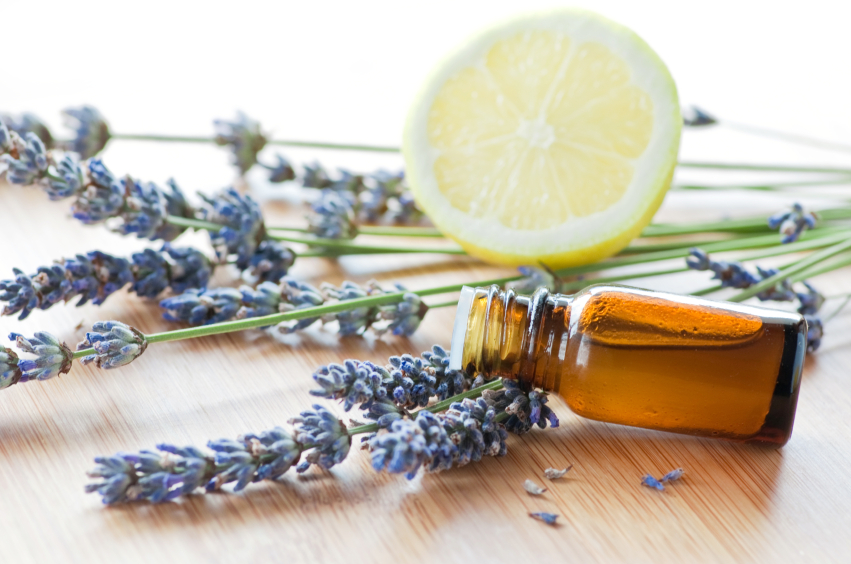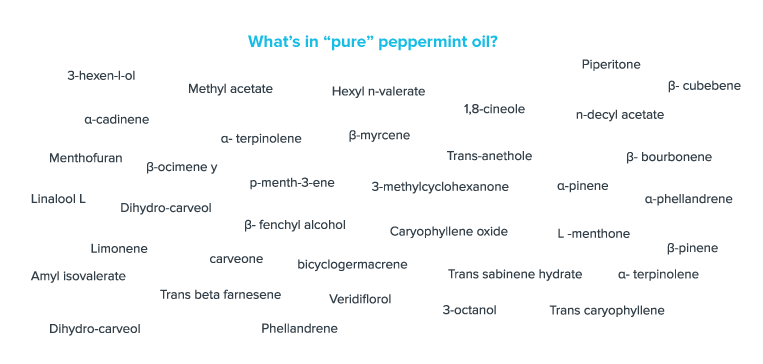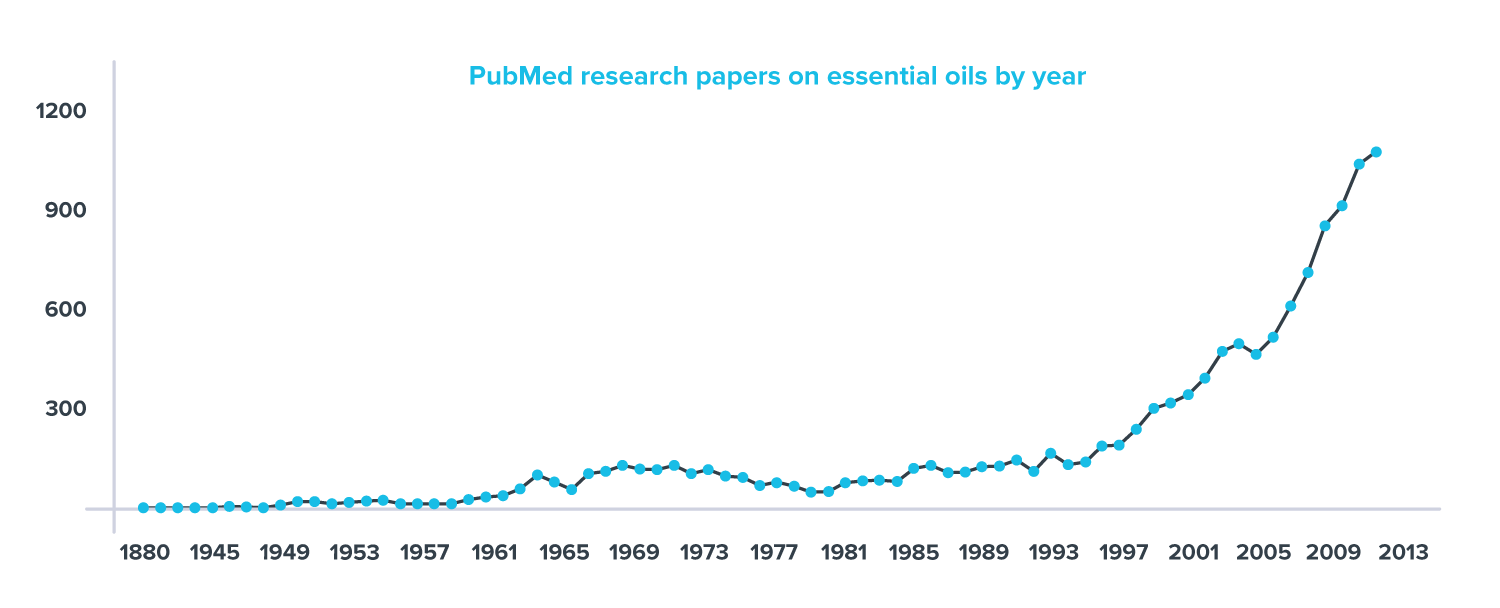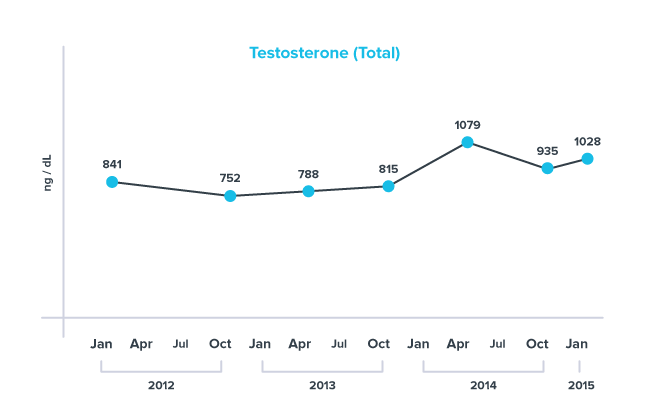Outrageous claims aside, essential oils do have actual health benefits. Here’s the real deal, including data from our very own (and very successful) self-experiments.
Want to listen instead of read? Download the audio recording here…
++
Earlier this year, I willed my testosterone level to increase by 26 percent.
I also successfully wished my 10-years-and-counting knee pain away.
And I used some magic vapor to reduce the number of sick days in my family (which includes three germy kids).
What sort of wizardry is this?
Just a little science. And a healthy dose of therapeutic essential oils.
I know, I know. The claims about essential oils — that they can help with sleep, mood, hormone levels, and more — can sound like scammy, woo-woo nonsense. The worst “health” advice the Internet has to offer.
Yet there’s intriguing scientific data suggesting that some of the potential benefits of essential oils might just be a reality.
For example:
- I’ve seen several case studies showing 25-35 percent increases in testosterone among hypogonadal (low-testosterone) men who ingested essential oil from blue spruce. (Spoiler alert: I saw the same increases when I experimented with blue spruce myself).
- Frankincense essential oil comes from resin of the boswellia tree. Boswellia is highly touted in the supplement world for joint pain and arthritis. Ironically, some of the same people taking boswellia in supplement form still end up mocking the use of essential oils. (Personally, I found it to be really helpful for my occasional knee pain).
Sure, you argue, small scale trials and simple case studies don’t “prove” or “disprove” anything. But these are more than speculation and anecdotes.
In my opinion, they’re enough to start a conversation, maybe even spark laboratory scientists to start looking more deeply into what essential oils do in larger groups and more controlled settings.
As always, it usually takes science a little while to catch up.
In the meantime, I’ve been experimenting with the help of my friend and colleague, Tom Nikkola.
Tom knows everything there is to know about the current state of the science on essential oils. He’s an impressive writer and researcher in his own right, and — full disclosure — he believes enough in the merits of essential oils that he’s now focusing his career on them full-time: He joined his wife’s website, through which they sell and educate about essential oils.
Biased? Maybe. At the same time, he delivers a fantastic roundup of essential oil intel.
What follows is the best, most helpful, and most comprehensive essential oil article I’ve seen to date.
Enter Tom…

What are essential oils?
Essential oils are the volatile liquids found in a variety of plants, trees, shrubs, and citrus fruit rinds. They’re what give herbs, flowers, and fruits their distinctive scents.
They’re also some of the oldest known “natural health products”.
For several thousand years, people all over the world have been extracting these oils using methods such as steam distillation, cold pressing, resin tapping, or absolute extraction.
Essential oils aren’t there by accident, or just because a flower decided to smell nice. The chemical components help the plants function and fight pathogens, disease and stress.
For instance, these components can:
- act as chemical messengers and hormones;
- protect the plant from bacteria, fungi, and viruses; and
- protect the plant from environmental stressors such as heat.
These active compounds are such small molecules that humans can easily absorb them through the skin, nasal passages, lungs, and digestive system.
Since plant physiology is similar enough to our own, we can get therapeutic benefit from some of the oils’ constituents.
Of course, every essential oil affects the human body in different ways, based on the dozens (or hundreds) of compounds in each oil.
For example, peppermint has more than 40 known constituents. (And probably a bunch of unknown ones). It’s been shown to:
- soothe the digestive system,
- relax tight muscles,
- be mentally and physically stimulating, and
- help lower blood lactate levels during exercise.

From skeptic to believer
I have to admit, I started out as a major essential oil skeptic. My wife first brought some oils home and got pretty deep into researching and using them.
I thought it was a crock.
Despite all of the research studies I’d read, professionals I’d learned from, and nutritional products and supplements I’d designed for top companies, I hadn’t seen much info on essential oils.
I work in the fitness industry, and it’s usually at the forefront of natural products and alternative therapies. Since no one in fitness was talking about these oils, I mistook this lack of dialogue for a lack of data.
To me, essential oils smelled nice, were used in mind-body programs, and were popular with non-scientific New-Agey types. Not scientists.
But I was sharing a house with someone who kept insisting there was good science. So I decided to take a deeper look. I even did some self-experimentation.
- I immersed myself in the available research and books on essential oils. (There’s more than you think.)
- I did before-and-after blood testing and experienced a marked improvement in my hormone balance. For example, I saw a 34 percent increase in my testosterone levels using blue spruce oil.
- A little later, I ruptured my distal bicep tendon deadlifting. Not a thrilling experience, to say the least, but I took it as an opportunity to test the effects of certain essential oils on supporting the healing process (in conjunction with nutrition, exercise, physical therapy and cryotherapy). The rehab team frequently commented about how quickly I was recovering (and how great I smelled). In the end, I was back to normal deadlifts in half the time the surgeon said it would take.
Over time, based on the research and my own experience, I became a believer. In fact, I kicked myself for not looking into these natural products earlier.
At the same time, I had — and continue to have — some concerns.
Like many products in the health and fitness space, essential oils are the subject of many outlandish claims that are either patently false or unverifiable.
Here’s my take on what the science and personal experimentation shows… and where I remain cautious, even skeptical.
How do essential oils work?
The three most common methods for using essential oils are:
- topical application,
- inhalation, and
- ingestion.
Most pure essential oils can be used all three ways — but be careful: Not all essential oils are pure.
Inhalation
Essential oils are most known for their odor (hence the term aromatherapy).
Inhaling essential oils stimulates any of more than 1,000 receptors in the nasal cavity, which transfer signals through the olfactory bulb to the limbic system, the center for our emotions. From there, they can affect the autonomic nervous, endocrine, and immune systems.
When essential oils reach the lungs, they pass from the alveoli into the capillary blood vessels. Once in the bloodstream, they are small enough to pass through the blood-brain barrier.
Inhaling certain essential oils may:
- help improve mood, emotions, and libido;
- support sleep quantity and quality;
- increase focus or alertness; and/or
- reduce feelings of stress or occasional anxiety.
Topical application
You can apply essential oil on its own or diluted with a “carrier oil” (such as avocado, coconut, olive, or sesame).
Diluting essential oils:
- minimizes the sensation on the skin and slows absorption (especially important if you’re using the oil on a child),
- allows you to spread the oil across a larger surface, and
- helps the oil’s effect last longer.
After penetrating the skin, essential oils can act locally (for instance, on your knee if you’ve rubbed the oil on your knee).
Or they can act systemically, throughout the body. If you’re looking for a systemic effect, one of the best places to apply the oil is the soles of the feet, since the pores there are large and essential oils are thus absorbed quickly.
Topical use of certain essential oils may:
- help target specific areas such as the sinuses, lymph system or the stomach
- have many of the benefits associated with inhalation; and/or
- relieve muscle soreness or joint stiffness from workouts, or other minor aches and pains.
Ingestion
The ingestion of essential oils might be one of the most debated topics in alternative health today.
I would not, under any circumstance, recommend ingesting cheap, perfume-grade essential oil. Although most pure essential oils can be ingested, there isn’t always a good reason to do it.
Research indicates that ingesting certain essential oils may:
- help us digest and absorb food;
- help relieve occasional digestive distress;
- help relieve symptoms of digestive issues like gingivitis, colitis, Irritable Bowel Syndrome and dysbiosis;
- support the immune system; and/or
- support normal inflammatory levels.
Personally, I’ve noticed my stomach feels much better after consuming certain essential oils with food. I’ve also heard this from many other people. So take that for what’s it worth.
Heads up: The first time I took blue spruce oil, I dropped it in a capsule and swallowed it with a tall glass of water. A few minutes later, I burped and it tasted like I’d eaten a spruce tree.
Essential oils are hydrophobic, meaning they rise to the top when mixed with water. Taking them with a fat-containing meal or a small amount of carrier oil helps disperse them through the digestive system (and eliminates pine-forest burps).
Where’s the science?
One of the arguments against essential oils is that there isn’t enough research on them: Without multiple double-blind, placebo-controlled studies, what do we really know?
Simply put, this isn’t true. There has been a significant increase in published research on essential oils in recent years, as you can see below:

Scientists are beginning to test various oils and their constituents.
Unfortunately, we’ll probably never see as many double-blind, placebo-controlled trials on essential oils as there are on pharmaceuticals or patented supplements.
Not because they don’t work. But because…
Essential oil research is really expensive.
With as many as a few hundred constituents per plant, each offering a different health benefit, study designs can vary dramatically.
For example, there’s evidence that chamomile oil has anti-inflammatory and anti-cancer properties, and may help with:
- symptoms of the common cold
- cardiovascular conditions
- colic/diarrhea
- eczema
- gastrointestinal conditions
- hemorrhoids
- osteoporosis
- sleep quality
- diabetes
- wound healing
- anxiety
Chamomile may even boost quality of life in cancer patients.
To do large-scale, repeatable studies on just one of the effects observed from this essential oil would be quite expensive.
No one wants to pay for the research.
Supplements and pharmaceuticals are often patented. Companies that own the patents do whatever studies they need to prove that their products work.
But plants that essential oils come from are living things in the public domain and therefore can’t be patented. Where there’s no patent, there’s often no profit.
The body of evidence is too muddy.
Plants grown outside their normal environment will not produce the right mix of constituents for therapeutic use. Oils that weren’t distilled properly lose constituents.
Unfortunately, some research studies have used these sub-par oils, which yield sub-par results.
At the same time, that doesn’t preclude good science being done on essential oils.
Dr. John Berardi’s experiment:
Essential oils for testosterone and growth hormone
Case studies suggest that blue spruce oil and balsam fir oil can support optimal testosterone and growth hormone levels, respectively. Dr. Berardi decided to try this out on himself. Here’s his report.
Method
Step 1: Get a baseline
For baseline measures, I tested morning-fasted levels of dozens of blood chemistry markers. (I used the WellnessFX Wellness Complete package).
This included hormonal markers like:
- total testosterone
- free testosterone
- sex hormone-binding globulin (SHBG)
- insulin-like growth factor-1 (IGF-1)
- luteinizing hormone (LH)
- follicle-stimulating hormone (FSH)
Step 2: Add experimental substance
After that I ingested 4 drops of blue spruce oil + 4 drops of balsam fir oil with breakfast and again with dinner for 8 weeks.
To do this I simply added 4 drops of each oil to an empty supplement capsule, closed it up, and washed it down with water at each meal.
During this time I kept my diet, exercise program, and usual routine the same.
After 8 weeks I repeated the same morning-fasted blood tests.
Results
Total testosterone (+26%), IGF-1 (+18%), and free testosterone (10%) all went up.
This makes sense as LH (+78%) and FSH (50%) both increased pretty substantially.

Comments
8 drops/day of blue spruce and balsam fir did increase markers of Testosterone and Growth Hormone… for me.
To demonstrate that this isn’t an isolated thing, I recently saw a report where 3 hypogonadal men were given the same dose of blue spruce oil and this is what happened.

Also, a good friend of mine saw a 34% increase in total testosterone (from 815 ng/dL to 1079 ng/dL) with blue spruce oil. So maybe this works for men across all ranges of Testosterone production.

To give you some context, the first 4 measures are “baseline”. These are testosterone levels collected over 2 years and, as you can see, they’re pretty stable.
The 5th measure was taken after a few months of using blue spruce alone (8 drops a day; no other major lifestyle changes). As you can see, a 35% increase above the averaged baseline.
The 6th measure was taken after cutting back to 4 drops a day; no other major lifestyle changes. And the 7th measure was taken after going back to 8 drops a day; no other major lifestyle changes.
Sure, none of these data are part of a peer reviewed research project. But they’re enough — at least for me — to think it’s worth further investigation.
Specific oils and their benefits
Here’s a summary of some of the more interesting published research available to date on essential oils. (For a full list of references, see the reference section at the end of this article).
Peppermint
May improve athletic performance
In studies, one drop of peppermint on the tongue, or in mineral water was associated with:
- improved grip strength, vertical jump, and standing long jump, visual and auditory reaction time, and heart rate variability both five minutes and 60 minutes after use
- improved lung capacity and blood lactate after 10 days of daily ingestion. Carbohydrate metabolism increased, suggesting an increase in energy production in muscle tissue. Heart rate during exercise also improved.
Inhalation of peppermint:
- decreased quarter-mile run time
- increased push-up performance and grip strength
May improve GI health
- Peppermint has been shown to relieve discomfort and occasional abdominal pain by relaxing the smooth muscle of the digestive tract.
May give you good looks
- Peppermint was also shown (in an animal study) to significantly stimulate hair growth.
Lavender
Lavender is the most often used essential oil in the world. It’s also the most adulterated, as the demand far exceeds the supply. The oil is distilled from the flowers.
May improve sleep
Inhaling lavender before or during the early stages of sleep:
- enhanced deep sleep, and/or
- improved sleep quality.
May improve relaxation and calm
Inhaling lavender:
- can lower autonomic nervous system arousal (i.e. the stress response), including lowering blood pressure, heart rate, and skin temperature;
- has been shown to lower cortisol levels; and/or
- can stimulate alpha wave brain activity (which tends to happen when our brain is “idling” — daydreaming or meditating)
When lavender and rosemary (which have somewhat similar scent profiles) were compared, lavender was relaxing while rosemary was stimulating.
May decrease pain
Among women who’d had Caesarean sections, those in the lavender group showed a significantly lower level of perceived pain at four, eight and 12 hours post-op.
May improve focus and trust
Lavender reduced reaction time, which would be expected being since it is sedating. But interestingly, it helped enhance attention during a long-term task.
Smelling lavender also increased feelings of interpersonal trust.
Citrus
Citrus oils are cold-pressed from the rind of the fruit.
May calm us and boost our mood
Oil of bergamot (which is part of the citrus family) can calm the nervous system; support sleep, increase relaxation and alleviate occasional feelings of anxiety.
Orange essential oil may do the same.
May stimulate us
Lemon and grapefruit, on the other hand, may boost our mood, wake us up, and get the brain moving. (Which is perhaps why many cleaners are lemon-scented.)
Other interesting findings
In studies:
- Pepper, tarragon, fennel and grapefruit fire us up: Each of these essential oils each stimulated sympathetic nervous system (SNS) activity 1.7 to 2.5-fold. Pepper oil increased adrenaline concentrations.
- Rose and patchouli oils chill us out: These inhibited SNS activity. Rose decreased adrenaline levels.
- Jasmine improved sleep quality. Jasmine is often used as a perfume, as many find its aroma seductive.
- Inhalation of neroli (bitter orange) by postmenopausal women lowered blood pressure, increased sexual desire, lowered stress levels and stimulated the endocrine system.
- The essential oil of Laurus noblis (bay laurel), which is typically thought of as a spice for cooking, when inhaled, enhanced alertness and reactions to unpredictable stimuli.
- Animal research shows that ingesting essential oils can aid in relieving symptoms from digestive issues such as colitis and intestinal dysbiosis.
- About 2-3 drops per day of lemongrass reduced cholesterol levels in adults with high cholesterol levels.
- Essential oils high in beta-caryophyllene (found in cloves, rosemary, hemp, and hops) have antioxidant and anti-inflammatory properties. Beta-caryophyllene (BCP) is most highly-concentrated in copaiba, from a group of South American trees in the Copaifera genus. Interestingly, this constituent is also found in cannabis.
More at-home experiments with essential oils
About 300 essential oils are available worldwide. Some oils have a more pronounced effect on one person than they have on another.
If you want to experiment yourself, get a high-quality, cold-air, ultrasonic diffuser, and 10-12 essential oils. As you gain experience, you’ll learn to mix oils together for various effects.
For some examples, check out this less scientific anecdotal data from my own DIY experience:
- Sleep: My lights-out formula is a combination of orange, cedarwood, ylang ylang and a few coniferous oils. (Some people swear by lavender, but it doesn’t work for me.)
- Energy: I use peppermint or a rosemary-black pepper blend before workouts.
- Mojo: Blue spruce supports my hormone balance. (To be clear, I’m a guy. If you’re female, make sure you get the right mix for you, and of course, if you’re pregnant or considering it, use caution.)
- Mojo 2: When my wife uses just a drop of jasmine essential oil as a perfume, I have a hard time keeping my hands off her.
- Digestion: A tarragon-ginger-anise-patchouli blend helps with my occasional digestive issues.
- Concentration and creativity: Citrus oils, spearmint and onycha in the diffuser on my desk smell great and keep me focused and productive.
What to do next
As we look to the future, we ought to pay attention to the past. Humans might not have known pharmacology or been able to identify the constituents found in essential oils 3,000 years ago.
Early health and medicine was trial, error, and observation. Using anecdotal evidence to learn about health benefits is okay, too.
Essential oils will likely become far more mainstream in the health and fitness world over the next few years.
Until then, consider these next steps:
1. Start with healthy-lifestyle basics.
While essential oils can have a powerful effect on our health, they can’t do it alone. We still must support our bodies with proper nutrition, exercise, and lifestyle choices.
Once those are solid, essential oils might help you get that extra little bit of improvement. Oils may even make fitness and health come easier, since they can boost your mood and help you recover better.
Our emotions have a significant effect on our decision making. When we’re stressed, bummed out, or irritated, it’s much easier to reach for junk food and skip workouts, so I do feel strongly that inhaling essential oils throughout the day can help us make better basic lifestyle decisions.
2. Try essential oils out for yourself.
Be objective, collect careful measurements, and if possible, try a control (such as a similar-smelling oil, or different methods of application).
Start with a clear baseline and change one variable at a time (such as oil type or method of ingestion) so you can track changes. Self-experiments (like this and this) are fun and really enlightening.
3. Stay scientific, skeptical and curious.
If you’re comfortable with research, spend some time reading in PubMed, or check out some of the papers or books referenced in this article.
If you happen to be a university or grad student, consider researching essential oils. Based on the current state of the art, I can think of dozens of interesting research questions worth answering.
4. Be wary of grandiose health claims.
Nothing cures everything. Even if something has very real effects, those effects will probably be small to moderate.
It goes without saying, but I’m going to say it anyway: Medical problems should be dealt with under the advisement of a competent healthcare practitioner. Though essential oils may help with certain symptoms or issues, they are not a replacement for medical therapy if that is what is advised from your healthcare practitioner.
5. Use high-quality oil.
It’s estimated that only 2 percent of essential oils are of therapeutic quality. The rest are made simply to smell nice.
When we talk about health benefits, we’re referring to high-quality, therapeutic essential oils, not the cheap stuff.
6. Get guidance.
Few people actually know what they’re doing. If you’d like some help with self-experimentation or exploring the research, we recommend doing it with the help of an experienced coach or healthcare practitioner.
Don’t go into the woods without science!
References
Click here to view the information sources referenced in this article.
If you’re a coach, or you want to be…
You can help people build sustainable nutrition and lifestyle habits that will significantly improve their physical and mental health—while you make a great living doing what you love. We'll show you how.
If you’d like to learn more, consider the PN Level 1 Nutrition Coaching Certification. (You can enroll now at a big discount.)


Share